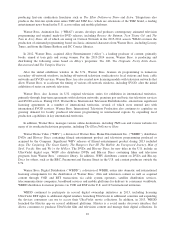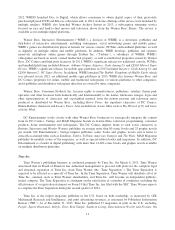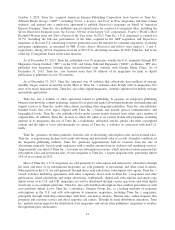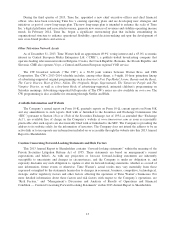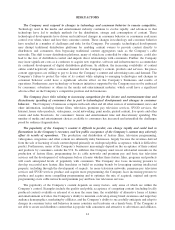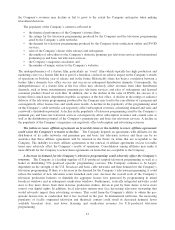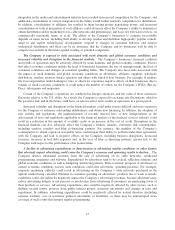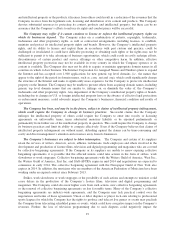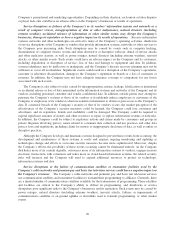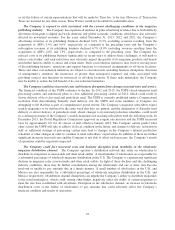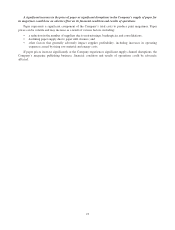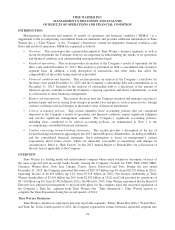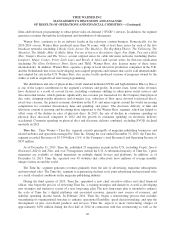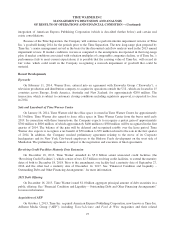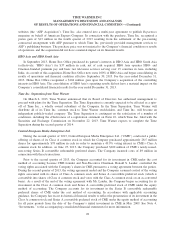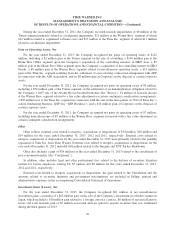Time Magazine 2013 Annual Report Download - page 36
Download and view the complete annual report
Please find page 36 of the 2013 Time Magazine annual report below. You can navigate through the pages in the report by either clicking on the pages listed below, or by using the keyword search tool below to find specific information within the annual report.Company’s promotional and marketing opportunities. Depending on their duration, such union or labor disputes
or player lock-outs could have an adverse effect on the Company’s businesses or results of operations.
Service disruptions or failures of the Company’s or its vendors’ information systems and networks as a
result of computer viruses, misappropriation of data or other malfeasance, natural disasters (including
extreme weather), accidental releases of information or other similar events, may disrupt the Company’s
businesses, damage its reputation or have a negative impact on its results of operations. Because information
systems, networks and other technologies are critical to many of the Company’s operating activities, shutdowns
or service disruptions at the Company or vendors that provide information systems, networks or other services to
the Company pose increasing risks. Such disruptions may be caused by events such as computer hacking,
dissemination of computer viruses, worms and other destructive or disruptive software, denial of service attacks
and other malicious activity, as well as power outages, natural disasters (including extreme weather), terrorist
attacks, or other similar events. Such events could have an adverse impact on the Company and its customers,
including degradation or disruption of service, loss of data and damage to equipment and data. In addition,
system redundancy may be ineffective or inadequate, and the Company’s disaster recovery planning may not be
sufficient to cover all eventualities. Significant events could result in a disruption of the Company’s operations,
customer or advertiser dissatisfaction, damage to the Company’s reputation or brands or a loss of customers or
revenues. In addition, the Company may not have adequate insurance coverage to compensate for any losses
associated with such events.
The Company is also subject to risks caused by misappropriation, misuse, leakage, falsification or intentional
or accidental release or loss of data maintained in the information systems and networks of the Company and its
vendors, including personnel, customer and vendor confidential data. In addition, outside parties may attempt to
penetrate the Company’s systems or those of its vendors or fraudulently induce employees or customers of the
Company or employees of its vendors to disclose sensitive information to obtain or gain access to the Company’s
data. If a material breach of the Company’s security or that of its vendors occurs, the market perception of the
effectiveness of the Company’s security measures could be harmed, the Company could lose customers and
advertisers, and its reputation, brands and credibility could be damaged. The Company could be required to
expend significant amounts of money and other resources to repair or replace information systems or networks.
In addition, the Company could be subject to regulatory actions and claims made by consumers and groups in
private litigation involving privacy issues related to consumer data collection and use practices and other data
privacy laws and regulations, including claims for misuse or inappropriate disclosure of data, as well as unfair or
deceptive practices.
Although the Company develops and maintains systems designed to prevent these events from occurring, the
development and maintenance of these systems is costly and requires ongoing monitoring and updating as
technologies change and efforts to overcome security measures become more sophisticated. Moreover, despite
the Company’s efforts, the possibility of these events occurring cannot be eliminated entirely. As the Company
distributes more of its content digitally, outsources more of its information systems to vendors, engages in more
electronic transactions with consumers and relies more on cloud-based information systems, the related security
risks will increase and the Company will need to expend additional resources to protect its technology,
information systems and data.
Service disruptions or the failure of communication satellites or transmitter facilities used by the
Company’s cable networks and premium pay and basic tier television services could have a negative impact on
the Company’s revenues. The Company’s cable networks and premium pay and basic tier television services
use communication satellites and transmitter facilities to transmit their programming to affiliates. Currently, there
are a limited number of communications satellites available for the transmission of programming. These satellites
and facilities are critical to the Company’s ability to deliver its programming, and shutdowns or service
disruptions pose significant risks to the Company’s businesses and its reputation. Such events may be caused by
power outages, natural disasters (including extreme weather), terrorist attacks, failures or impairments of
communications satellites or on-ground uplinks or downlinks used to transmit programming, or other similar
events.
20


